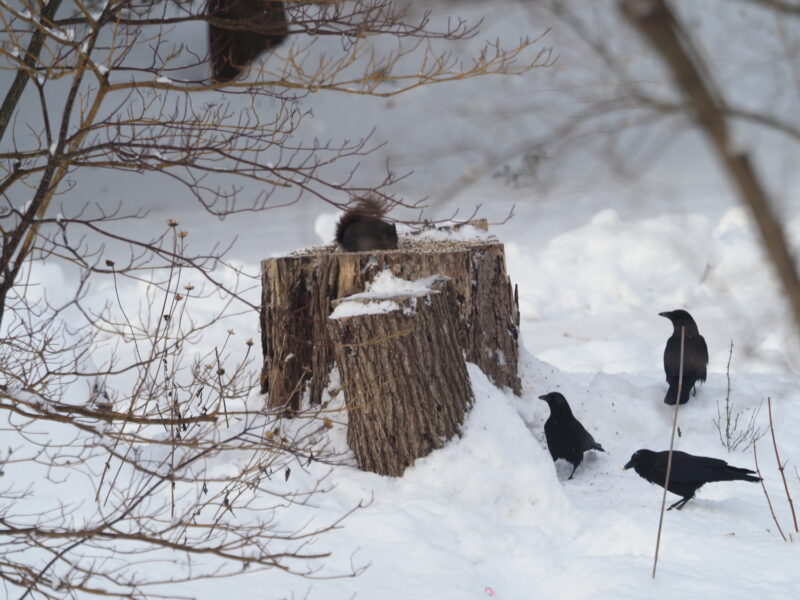

As I look out my office windows there’s a preponderance of brown and gray on this misty, foggy, drippy December day. Official winter is still days away, and yet I’m beginning to have longings for spring. However, there are two things I see that give me solace as I yearn to plant. The magnolia buds are incredulous and continue to plump up despite it all. And on the other side of the house is an old maple tree stump that will get me through the winter. A tree stump?
A number of years ago we had to take down a large sugar maple that was in decline and had become a liability should it collapse or break apart. That process had already started, and being on the property line I didn’t want the tree falling on my neighbor’s driveway or across my lawn, so down it came. Left behind was a 3-foot-tall, 36-inch-diameter stump. To remove it would cost nearly $1,000, so it stayed. Funny thing is, it’s provided me with days and days of winter joy. It’s become my stump bird feeder.
In the warmer months I enjoy sitting on the front porch watching the birds explore the gardens as they scratch the soil and toss the leaf mulch looking for meals of insects, slugs and other delights. Those who forage above the ground are forever looking for other treats, from aphids to beetles and caterpillars. At the end of the season the finches, chickadees and juncos head to the sunflowers, Rudbeckias and Echinaceas to harvest their seeds as the flowers brown and the seeds ripen. This show goes on until the seeds have been totally harvested and the stems fall to the ground. Then it’s time for me to pay the birds back.
Every morning just before the sun rises, I bring out a pound or so of birdseed mix and spread it across the stump. Within a millisecond a chickadee or junco will land on the stump and begin to feed. They are comical, and if I stand still long enough with seed in my hand the chickadees will tentatively land on my hand, snatch seed and fly to the nearest branch to munch. About 15 minutes later the mourning doves arrive and drop one by one, then all at once from the trees nearby and they begin their morning routine.
Next is the small flock of about a dozen pigeons hitting the landing zone from all directions as the smaller birds are scattered and land on the ground below to feed on the seed everyone else is dropping. Then come the bullies, the blue jays. They intimidate the other birds who fly off, and it’s now their turn for some seedy breakfast. A gray squirrel stealthily sneaks up the side of the stump surprising the jays, and he dominates the stump until the big boys arrive. First one crow, then another and within an hour of putting the seed out most of it and bits of dried fruit are gone, but not all.
For the rest of the day it’s a very informal hit and miss of birds who come to claim one last sunflower seed found in a crevice or tiny millet seed or a peanut that’s fallen into a crack while the chickadees and juncos feed on what’s fallen to the ground below. Now and then there’s a sudden flash of red as a male cardinal drops in for a passing snack.
Inside, I’m sitting in my comfy chair by the fire watching my friends as they go through this daily routine. Once I start putting the seed out I feel obligated to give them seed every day until early spring when I wean them back to nature’s feast.
I do this routine for them but also for me. Other than the joy of watching them, I know that by feeding them these nonmigratory species will stick around the area and be here the entire year feeding, breeding and feeding more. It’s one great win-win situation. I did have reservations though and was wondering if feeding these birds and bringing them so close together could cause issues with the bird flu. I emailed my birding mentor, also a naturalist, Steve Coleman, and asked, am I making a mistake? He said “Not at all” and gave his opinion, which is gold in my book, that the flu was much more of a problem down south than up here.
At one point several years ago I was concerned that my stump feeder would result in a host of weeds emerging in the spring as sprouts from the bird seed. It seems to have been an unfounded fear as the only interlopers seem to be sunflower plants that pop up where the squirrels have planted them. But these invariably end up being feeding spots for the birds later in the season as they pick away at the large alluring flowers as the seed ripens.
One caution though. My stump feeder and any feeder exposed to the open sky is subject to occasional visits from hawks. I rarely see the “hit,” only knowing it occurred when I find the remnant pile of feathers on the ground nearby. It only happens once or twice a year, and it’s startling to watch, but still nature’s way.
Feeding these feathered friends in the winter isn’t enough though, and to be really effective I try to offer other feeding venues. This includes trees and shrubs with berries that they’ll eat and every gardener knows how much the birds love blueberries. But there are several other plants that they can feed on and from including Echinacea, Thistle, Rudbeckias, crabapples (all winter) and many more. Again, keep in mind the better you take care of them, the better they’ll take care of your garden. Even doing some pollinating.
If you’re taking down a tree you can set up a stump feeder like I did, but once the ground freezes and snow falls I’ll also set out a thistle feeder, a hanging feeder and a suet feeder as well. Each has its place and purpose.
Now there is a challenge in this pursuit and that’s keeping the squirrels away from the feeders. These cunning rodents will do just about anything, including acrobatics, to get to your feeder. And if the feeder isn’t squirrel proof with a baffle or metal protected feeding ports or holes…they’ll not only eat the food but destroy the feeder with their sharp teeth. One “trick” I use is to hang a feeder from a high limb using clothesline rope. The last eight feet of connection — the “rope” to the feeder — is either 20-pound-test fishing line or thin metal wire that the squirrels can’t grasp and shimmy down. The feeder still has to be close enough to the ground so you can refill it but not so close that the squirrels can jump up to it for from a nearby branch.
If you just want to feed chickadees, juncos, siskins and a few other birds, you should check out nyjer and thistle seed feeders. Nyjer seed and thistle seed is similar to a slimmed down rye seed, and these feeders have tiny slits on the sides of the cylinder that allows the birds to pick seeds out of the slit one at a time.
A suet feeder is usually a flat rectangular feeder that blocks of a fat cake filled with seeds and fruit are in. The feeder is hung like the other feeders and attracts woodpeckers, jays, nuthatches, titmice and chickadees. There are also types that can be attached to trees which will be great for the woodpeckers, who aren’t all that fond of hanging feeders.
Some people use window feeders that attach to the outside of a home window. This allows you see up close who’s feeding, but this type of feeder concerns me for two reasons. First, too many birds are already killed by hitting window glass. Second, I have reservations about bringing these guys so close to the house, which may encourage them to do some pecking to the woodwork looking for insects during the warmer months.
I know that Fowler’s Garden Center in Southampton has a great selection of feeders as will other garden centers, but the Fowler’s selection is pretty extensive. Bird feeders and the food that fills them are also great holiday presents that can delight not just the birds but kids and adults as well.
As far as what seed to buy and use, go for high quality. The best seed mixes are more expensive but when you use cheap seed you’ll quickly notice that most of it remains on the ground and uneaten just attracting rodents. Birds (and squirrels) will also eat unshelled (unsalted) peanuts, and black oil sunflower seeds are great for most birds. Avoid seed mixes that are mostly millet seed.
Don’t let bird seed accumulate on the ground under feeders as this will lead to attracting rodents including mice and rats. Store your seed in the bag you buy it in or even better in a metal can with a top. The seed should not be stored in a shed or spot where it will freeze, but a basement or garage attached to your house will be fine. Keep growing.
 More Posts from Andrew Messinger
More Posts from Andrew Messinger